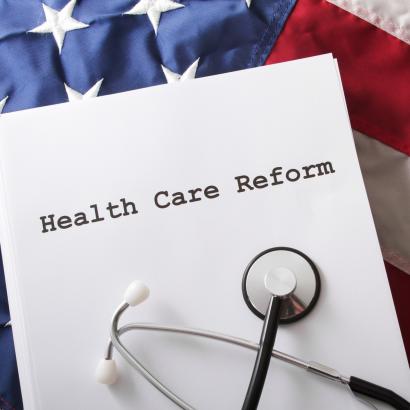Click here to download this proposal.
The Choices for All Project proposes Individual Health Accounts (IHAs) as a new tax savings vehicle for health spending and improving the tax treatment of out-of-pocket (OOP) medical spending. Both would increase federal deficits over the next ten years. Here we estimate the likely deficit effects of our proposals. We also consider potential “pay-fors” that could offset these budget effects if policymakers want deficit-neutral health reforms
Key Plan Elements
- Extending out-of-pocket (OOP) deductibility of health expenses would reduce ten-year federal revenues by $79 billion
- Separately, IHAs would reduce federal revenues by $82 billion over ten years if contribution limits were set at the 50th percentile of current ESI premiums
- Combined, IHAs and full deductibility of out-of-pocket spending would reduce federal tax revenue by $94 billion over ten years
- These policies could be paid for by ending the enhanced ACA subsidies from the Inflation Reduction Act or adding work requirements to Medicaid
The Choices for All Project features two significant changes to the US tax code that, without offsetting changes, would increase federal deficits over the next ten years. First, the project proposes a new tax savings vehicle for health spending: Individual Health Accounts. These accounts are akin to a mix of health savings accounts (HSAs) and individual retirement accounts (IRAs). Second, the project proposes improving the tax treatment of OOP medical spending. This spending would become an above-the-line tax deduction (i.e., it would reduce a taxpayer’s adjusted gross income).
Here, we offer three distinct estimates for our proposed tax changes. First, the budget costs of tax deductibility of out-of-pocket spending (without IHAs). Secondly, the budget costs of tax deductibility of IHAs (without extending deduction for OOP spending). We then consider the budget effects of IHAs paired with OOP deductibility. You can find a full overview of a methodology and estimates here.
Budget Costs of Tax Deductibility of Out-of-Pocket Spending (Without IHAs)
As the differential tax treatment between ESI premiums and OOP spending is reduced, more consumers would opt for lower-premium plans with more cost sharing. We estimate that the behavioral changes would reduce total health spending among those with ESI coverage by about $20 billion annually, or about 3.7 percent of health spending among those with ESI coverage (or self-employed) and enrolled in plans without HSAs or HRAs. The shift to higher cost-sharing would reduce premiums by as much as 10 percent among this group.
After accounting for these behavioral effects, we estimate that OOP deductibility would reduce federal tax revenue by $6 billion in 2023 and $79 billion over the ten-year budget window. We estimate income tax revenue would fall by $167 billion over ten years, but this would be offset by $88 billion in additional payroll tax revenue from reduced ESI premiums.
The $79 billion revenue loss over ten years is significant, but as noted above, it would mean a $20 billion initial reduction in health spending with larger savings in future years.
Budget Costs of Tax Deductibility of IHAs (Without Extending Deduction for OOP Spending)
All else constant, IHAs would reduce income tax revenue, particularly in the near term. While IHAs would be available to all non-Medicare recipients with public or private health insurance, changes in tax revenue would largely be due to tax-preferred contributions by those with ESI coverage who currently don’t use HSAs or HRAs. Consequently, our analysis here focuses on this subgroup. We consider two contribution limits for IHAs: the 50th percentile of current premiums and the 75th percentile of current premiums. The 50th percentile of premiums corresponds to approximately $25,000 for family plans and $8,600 for self-only plans (the 75th percentile thresholds would be $29,800 and $10,100). We assume the thresholds would grow with overall health care premium growth. Estimated revenue losses could be lower if the thresholds only grew at the rate of medical inflation.
We estimate that if the maximum contribution limit is set at the 50th percentile of ESI premiums, taxpayers would save approximately $30 billion in their IHAs in 2023. Over ten years, the federal government would lose $82 billion in revenue. If, instead, the maximum contribution limit was set at the 75th percentile of ESI premiums, taxpayers would save $66 billion in their IHAs in 2023. The loss in income tax revenue would be $12 billion in 2023 and $176 billion over the ten-year budget window.
Budget Effects of IHAs Paired with OOP Deductibility
Over the long-term, all IHA contributions would either be taxed or go to qualified out-of-pocket spending. The additional budget effects from adding IHAs to our extended OOP deductibility proposal are thus relatively small. Nevertheless, here we estimate short-run effects from both proposals. As noted above, our method here likely overstates the long-term cost of IHAs as it does not account for IHA withdrawals in subsequent years or changes in plan selection due to the availability of IHAs.
We estimate the combined revenue losses from IHAs and extending OOP deductibility would be $7 billion in 2023 and $94 billion over the ten-year budget window. While these costs should be viewed as an upper bound, they are nevertheless minor compared to recent health care reforms. The ACA’s coverage provisions, for example, were initially scored as costing $938 billion over its first 10 years—with nearly $900 billion in the second half the budget window. More recently, the Biden Administration has proposed permanently extending expanded ACA subsidies, which would increase ten-year budget deficits by $183 billion.
Potential “Pay-For” Options
Here we propose two potential pay-fors that will reduce federal health care costs while improving the system’s incentives. While we do not explicitly endorse either policy alternative, we present them here to illustrate possible policy alternatives that could produce necessary savings to compensate for the costs of instituting our own proposals.
The first potential pay-for proposes the end of temporary expansions of the ACA premium tax credits. While ACA enrollment has increased over the past years due to expansion reforms in the American Rescue Plan Act of 2021 and the Inflation Reduction Act of 2023, it has occurred at a high cost. While the extensions are now due to expire in January 2026, the Biden Administration is proposing to make these changes permanent. The President’s FY2024 budget request proposed $183 billion over ten years to “make the enhanced premium tax credits previously extended under the Inflation Reduction Act permanent.”
Ending these expansions beginning in 2024 would reduce current law baseline deficits by approximately $45 billion during the ten-year budget window. It would reduce the current policy baseline deficit by $227 billion.
The second potential pay-for proposes to create work requirements for able-bodied Medicaid recipients without dependents…Work requirements are not a new concept. In fact, they were used to great effect through the Personal Responsibility and Work Opportunity Reconciliation Act (PRWORA) in 1996 when the Aid to Families with Dependent Children program was replaced by the Temporary Assistance for Needy Families program. It stands as one of the most successful welfare reforms in American history. Dependency fell and employment increased.
Health care reform presents unavoidable trade-offs among cost, quality, and coverage, particularly in the short run. Our proposed reforms are no exception.
You can learn more about cost estimates and pay-fors here.
















